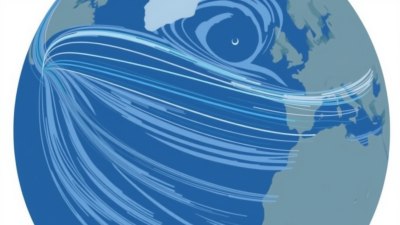Why Online Carts Fill Faster When the Wind Picks Up
Explore the intriguing phenomenon of how weather influences online shopping behavior and cart abandonment.

In recent years, the intersection of weather phenomena and consumer behavior has drawn significant attention from marketers and psychologists alike. One particularly interesting observation is the correlation between inclement weather, such as windy days, and an increase in online shopping activities. This article delves into the reasons why online carts seem to fill faster when the wind picks up, analyzing both psychological and practical factors that play a role in this fascinating trend.
Firstly, the relationship between weather and mood cannot be understated. When the wind picks up, it often brings with it a distinct chill and discomfort. People tend to seek out comfort in various forms, and for many, shopping online becomes a refuge. Whether it's purchasing cozy blankets, hot beverages, or other comfort items, individuals may find solace in filling their virtual carts with items that serve to counteract the dreariness of a windy day. This behavior can be attributed to a psychological need for warmth and comfort, both physically and emotionally.
Furthermore, the concept of 'nesting' comes into play during inclement weather. Nesting refers to the desire to make one’s home a more comfortable and welcoming space, particularly during seasons where adverse weather conditions prevail. As wind picks up and outdoor options diminish, consumers often turn to online platforms to improve their living spaces. This may involve buying home decor items, cooking appliances, or even arts and crafts supplies for indoor activities. Hence, the phenomenon has a strong linkage to the overarching tendency of individuals to create a cozy home environment.
The Role of Impulse Buying
Another noteworthy factor is the likelihood of impulse buying increasing during poor weather. The convenience of online shopping encourages spontaneous purchases without the hassle of physically navigating a brick-and-mortar store. With the wind howling outside, consumers find it easier to click and buy rather than brave the elements. Retailers have recognized this scenario and started to optimize their online platforms for quick shopping experiences, often implementing features such as one-click buying and recommendations based on browsing history. This easy access may lead to an increase in cart additions.
Additionally, psychological biases play a crucial role in consumer behavior during windy weather. Cognitive dissonance, where individuals experience discomfort due to conflicting thoughts, often emerges when one contemplates the choice between braving the wind to shop or opting for the comfort of online purchasing. The resolution often lies in the convenience of filling an online cart, alleviating the stress caused by outdoor conditions. Consequently, the comfort of shopping from home aligns perfectly with the psychological state of consumers, leading to increased online shopping activity.
Seasonal Trends and Marketing Strategies
Moreover, seasonal trends heavily influence shopping behavior. As winds pick up in specific seasons, retailers frequently launch targeted marketing campaigns aimed at promoting relevant products. For instance, autumn is marked by wind and cooler temperatures, prompting retailers to emphasize cozy apparel, home goods, and seasonal promotions. When customers view these advertisements, they are reminded of the weather and may feel compelled to act quickly before supplies run low, leading to faster cart fill-up rates.
This seasonal correlation extends to the type of products consumers are inclined to purchase. On particularly windy days, one can expect a surge in sales of items such as loungewear, indoor games, and comfort food ingredients. These product categories align well with the prevailing weather conditions, appealing directly to consumers’ instincts to nest and indulge during uncomfortable weather. Retailers that adjust their inventory and marketing strategies in anticipation of these trends are likely to see a direct impact on their sales metrics.
The Influence of Social Media
Social media also plays a significant role in driving online shopping behavior during windy weather. Influencers and brands alike leverage windy days as a backdrop for campaigns showcasing cozy apparel, home decor, and indulgent food. When individuals scroll through their social media feeds, they are often inspired by curated content that resonates with their current circumstances. This influence can lead to an increased desire to shop online, resulting in quicker additions to shopping carts.
Furthermore, during inclement weather, people tend to spend more time on their devices, which naturally leads to an increase in online interactions, including shopping. The juxtaposition of staying warm indoors while scrolling through social media encourages consumers to explore and purchase products fitting their needs. Brands can capitalize on this behavior by crafting engaging content that seamlessly integrates products into lifestyle scenarios, fostering a deeper connection with potential buyers.
The Immediate Gratification Factor
In our fast-paced society, the desire for immediate gratification often drives consumer behavior. Shopping online enables consumers to fulfill their desires quickly—something that becomes even more appealing when conditions outside are less than ideal. When the wind blows fiercely, the idea of venturing out to make purchases becomes less attractive compared to the ease of browsing online and receiving items at one’s doorstep. The prospect of convenience paired with the comfort of home can lead to significant cart filling during windy days as people act on their immediate needs and whims.
Implementing Last-Minute Deals
Additionally, retailers may employ strategies such as last-minute deals or flash sales during inclement weather to capitalize on the surge in online shopping. These tactics create a sense of urgency among consumers, prompting them to fill their carts more quickly and finalize transactions before time runs out. The combination of the wind driving people indoors and promotional incentives can lead to higher conversion rates for online stores.
Last-minute deals during windy weather can be particularly effective when combined with tailored marketing efforts. For example, an online store may choose to highlight products that cater to the specific needs brought on by windy weather, such as warm clothing, home improvement tools, or comforting snacks. This targeted approach not only increases cart fills but also enhances customer satisfaction as buyers find products that are relevant and timely.
In conclusion, the increase in online cart fills during windy weather can be attributed to a confluence of psychological, behavioral, and marketing factors. From the natural inclination to seek warmth and comfort indoors to impulse buying reinforced by targeted marketing efforts, the patterns that emerge during inclement weather create a unique landscape for online shopping. As retailers continue to navigate this evolving environment, understanding the complexities of consumer behavior in relation to weather will be crucial. By matching online shopping experiences with weather patterns, retailers can maximize their appeal to consumers, ensuring successful transactions even on the most blustery of days.











